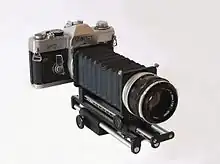

In photography, a bellows is the accordion-like, pleated expandable part of a camera, usually a large or medium format camera, to allow the lens to be moved with respect to the focal plane for focusing.[1] Bellows are also used on enlargers. The bellows provides a flexible, dark extension between the film plane and the lens.
Classification
Two kinds of bellows are commonly used on cameras; bag bellows are normally used with a lens of short focal length, and accordion bellows with a much longer range of extension. For large format cameras, “double extension” refers to bellows that extend to a length equal to about twice the focal length of a standard lens, e.g. 300 mm for the 4×5 inch format. “Triple extension” for the same format indicates bellows extension of 450 to 500 mm.
Flexibility
Bellows allow movements that can be used to correct distortion in a photograph and to avoid converging or diverging verticals. Use of a bellows-based camera can ensure that parallel elements in a scene remain parallel in the final photograph.
In some cameras, the photographer can change the angle of the film plate with respect to the optical axis of the lens, providing alterations of perspective distortion and of the object plane of focus. Bellows may be part of a camera or come as an optional accessory.
References
- ↑ "Digital vs Film Photography - The Pros and Cons". 2023-02-06. Retrieved 2024-01-05.